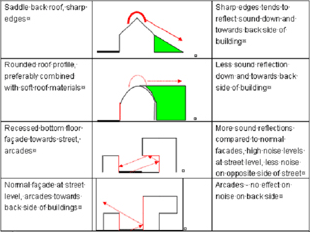SP4: Propagation & receiver parameters
Considerations
Subproject 4 explores new ways to reduce noise propagation and alter the receiver perception. The task of town planning is explored to engage in new possibilities of using new buildings in a variety of ways to help reduce noise an/or make it more acceptable to residents.
The benefits of following scenario's will be explored:
- Traditional sound walls,
- using continuous buildings as a sound wall,
- taking advantage of the orientation of the building, in combination with the internal layout of the building.
- Changes in perception of noise from the way buildings are designed with features that provide for a better, more acceptable perception of noise. The question of limiting noise in urban areas can no longer be restricted to transport noise sources. It's also an essential part of present town planning and development of sustainable and attractive living environments.
Workpackage 1: Quantify influence of propagation media and of screening effects
- Quantify influence of propagation media:
- absorbing or reflective surfaces
- urban typical formation, walkpaths ....
- open spaces, squares, green areas, vegetation.
- Quantify influence of screening effects:
- earth formations
- noise barriers.
Workpackage 2: Quantify influence of local town planning
Quantify influence of local town planning involving:
- and use planning
- type of building
- location of the building in propagation area
- building orientation in function of the source
- internal lay-out
- type external structure (walls, glazing, …)
- climatic conditions.
Workpackage 3: Define adequate performance evaluation tool
Definition of an adequate performance evaluation tool from receiver point of view including both physical descriptor, cost ratio and population opinion assessment procedures.

Workpackage 4: Propose solutions after preliminary theoretical assessment
Propose solutions in the area of noise propagation and receiver perception after preliminary theoretical assessment to be retained for further development after the 18 months initial period.